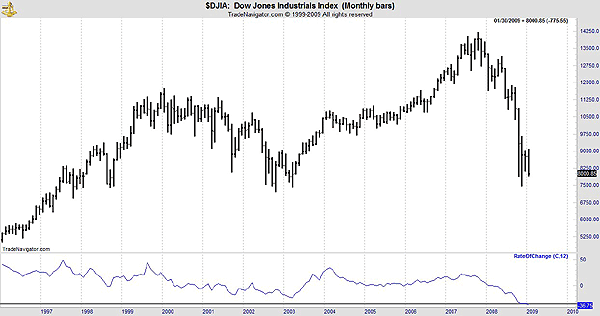
HOT TOPICS LIST
- MACD
- Fibonacci
- RSI
- Gann
- ADXR
- Stochastics
- Volume
- Triangles
- Futures
- Cycles
- Volatility
- ZIGZAG
- MESA
- Retracement
- Aroon
INDICATORS LIST
LIST OF TOPICS
PRINT THIS ARTICLE
by Mike Carr, CMT
"Oversold" does not mean "Buy now."
Position: N/A
Mike Carr, CMT
Mike Carr, CMT, is a member of the Market Technicians Association, and editor of the MTA's newsletter, Technically Speaking. He is also the author of "Smarter Investing in Any Economy: The Definitive Guide to Relative Strength Investing," and "Conquering the Divide: How to Use Economic Indicators to Catch Stock Market Trends."
PRINT THIS ARTICLE
OVERBOUGHT OVERSOLD
Oversold Markets
02/02/09 01:21:50 PMby Mike Carr, CMT
"Oversold" does not mean "Buy now."
Position: N/A
| Technical analysts often talk about a market being oversold or overbought. "Oversold" means the price has fallen so much that it is now severely undervalued and should represent a buying opportunity for investors. "Overbought" markets are those in which price has run up too fast and there is likely to be a shortage of new buyers. These conditions represent extremes and should occur rarely. |
| Figure 1 shows an example of an oversold market condition. Over the past 12 months, the Dow Jones Industrial Average (DJIA) has declined by more than 36%. In the brutal bear market that began in 2000 and ended in 2002, the rate of change never exceeded 25%. The severity of this bear market is unusual. |

|
| FIGURE 1: DJIA, MONTHLY. The DJIA appears to be oversold. |
| Graphic provided by: TradeNavigator.com. |
| |
| Looking to history as a guide of what to expect next, we find that the market reached this level of extreme downward movement in 1974, very close to the ultimate bear market bottom (Figure 2). After declining by 35.8% in the 12 months ended in September 1974, the market rose by 70% over the next 15 months. |

|
| FIGURE 2: DJIA, MONTHLY. The 1974 bear market bottom occurred after the market became oversold, reaching a level almost as severe as the current reading. |
| Graphic provided by: TradeNavigator.com. |
| |
| Looking further back in history, we see that the market became this oversold in August 1930 as well (Figure 3). But that time the market stayed oversold until March 1933, falling another 75% after becoming oversold. |

|
| FIGURE 3: DJIA, MONTHLY. Oversold markets can stay oversold, as the DJIA did in the 1930s. |
| Graphic provided by: TradeNavigator.com. |
| |
| While history offers a guide as to what we can often expect the market to do, it is more often than not an inconclusive guide. Stocks may turn higher from this oversold level, or they may remain oversold and decline further. Time will tell, and technicians touting a once-in-a-lifetime buying opportunity on cable news should be ignored. |
Mike Carr, CMT, is a member of the Market Technicians Association, and editor of the MTA's newsletter, Technically Speaking. He is also the author of "Smarter Investing in Any Economy: The Definitive Guide to Relative Strength Investing," and "Conquering the Divide: How to Use Economic Indicators to Catch Stock Market Trends."
| Website: | www.moneynews.com/blogs/MichaelCarr/id-73 |
| E-mail address: | marketstrategist@gmail.com |
Click here for more information about our publications!
PRINT THIS ARTICLE

|

Request Information From Our Sponsors
- StockCharts.com, Inc.
- Candle Patterns
- Candlestick Charting Explained
- Intermarket Technical Analysis
- John Murphy on Chart Analysis
- John Murphy's Chart Pattern Recognition
- John Murphy's Market Message
- MurphyExplainsMarketAnalysis-Intermarket Analysis
- MurphyExplainsMarketAnalysis-Visual Analysis
- StockCharts.com
- Technical Analysis of the Financial Markets
- The Visual Investor
- VectorVest, Inc.
- Executive Premier Workshop
- One-Day Options Course
- OptionsPro
- Retirement Income Workshop
- Sure-Fire Trading Systems (VectorVest, Inc.)
- Trading as a Business Workshop
- VectorVest 7 EOD
- VectorVest 7 RealTime/IntraDay
- VectorVest AutoTester
- VectorVest Educational Services
- VectorVest OnLine
- VectorVest Options Analyzer
- VectorVest ProGraphics v6.0
- VectorVest ProTrader 7
- VectorVest RealTime Derby Tool
- VectorVest Simulator
- VectorVest Variator
- VectorVest Watchdog
